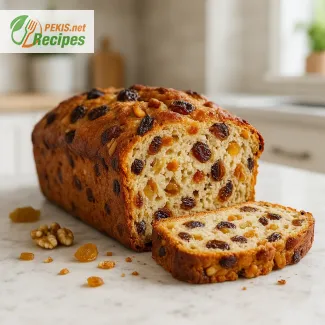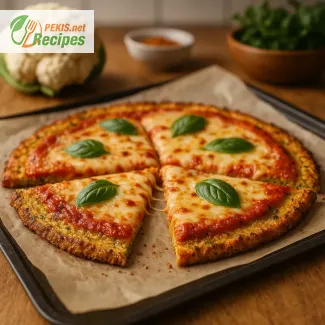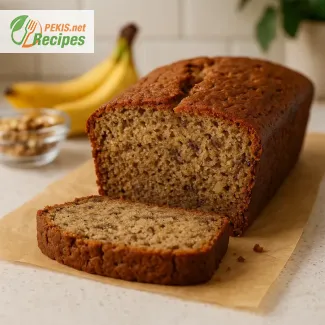
The Ultimate Moist and Tender Banana Bread Without Gluten
A naturally sweet and fluffy treat for any time of the day
There’s something universally comforting about a warm slice of banana bread — its soft crumb, delicate sweetness, and the unmistakable aroma that fills the kitchen as it bakes. But for those avoiding gluten, finding a recipe that delivers the moist texture and rich banana flavor of classic banana bread can feel impossible. This gluten-free banana bread recipe bridges that gap with ease. Whether you're managing celiac disease, reducing gluten for dietary reasons, or simply exploring new baking horizons, this recipe ensures no compromise on flavor or texture.
Crafted with simple, wholesome ingredients, this loaf is naturally gluten-free, yet indistinguishable from traditional versions. The star, of course, is the ripe banana — not just a source of sweetness, but also a natural binding agent that adds incredible moisture. When combined with the right mix of gluten-free flour, a touch of natural sweetener, and the right fat for tenderness, the result is a banana bread that’s perfectly soft on the inside with a slightly crisp crust.
What makes this gluten-free banana bread stand out is its balance of texture and taste. The crumb is light, tender, and springy, never gummy or dry. The use of high-quality gluten-free flour blends, often made from rice flour, tapioca starch, or potato starch, ensures that structure is maintained without the chewiness of gluten. A small amount of baking soda and baking powder creates the perfect rise, giving this loaf a classic shape and a melt-in-your-mouth bite.
Another secret lies in using extra ripe bananas — their skins nearly black and the fruit inside incredibly soft and sweet. These bananas are packed with natural sugar and flavor, which translates into a banana bread with deep banana character and golden caramel undertones. The richness of the banana is further enhanced with a splash of pure vanilla extract and, optionally, warm spices like cinnamon or nutmeg for added complexity.
For added texture, some variations of this recipe include chopped nuts such as walnuts or pecans. Others incorporate dark chocolate chips, creating a fusion of indulgence and nutrition. Still, the classic version remains a timeless favorite — one you can enjoy for breakfast, as a snack, or even as a healthier dessert.
The best part? This banana bread is incredibly easy to prepare, even for novice bakers. With just one mixing bowl, a few pantry staples, and a loaf pan, you’re only a few steps away from baking a satisfying gluten-free treat that your whole family will love. It freezes well, slices cleanly, and stays moist for several days — making it a great choice for meal prep or gifting.
What you get is a gluten-free banana bread that’s moist, fluffy, and bursting with banana flavor. It’s the kind of recipe that proves that gluten-free baking doesn't have to feel like a compromise. On the contrary — when done right, it can be even better. Every bite offers the familiar warmth of homemade banana bread, with a texture so tender and flavor so rich, you'll forget it's gluten-free at all.
Whether you're enjoying it plain, spread with a pat of butter, drizzled with honey, or topped with a spoonful of nut butter, this banana bread is versatile and endlessly satisfying. Its warm, comforting flavor and tender crumb make it the kind of bake that turns into a family favorite — the recipe you’ll return to again and again, not just because it’s gluten-free, but because it’s simply delicious.
Step 1 – Preheat the oven and prepare the loaf pan
Preheat your oven to 175°C (350°F). Line a 22 x 12 cm (9 x 5 inch) loaf pan with baking paper or lightly grease it with oil.
Step 2 – Mash the bananas
Peel and mash the ripe bananas with a fork in a large mixing bowl until smooth with a few small lumps.
Step 3 – Add wet ingredients
Add the eggs, brown sugar, sunflower oil, milk, and vanilla extract to the mashed bananas. Whisk until fully combined.
Step 4 – Combine dry ingredients
In a separate bowl, mix the gluten-free flour blend, baking powder, baking soda, cinnamon, and salt. Stir to distribute evenly.
Step 5 – Mix wet and dry ingredients
Gradually fold the dry mixture into the banana mixture. Stir until the batter is smooth and lump-free. If using nuts or chocolate chips, gently fold them in at this stage.
Step 6 – Transfer to the loaf pan
Pour the batter into the prepared loaf pan and smooth the top with a spatula.
Step 7 – Bake
Bake for 50 minutes, or until a toothpick inserted into the center comes out clean. If the top browns too quickly, tent loosely with foil during the last 10–15 minutes of baking.
Step 8 – Cool and serve
Let the banana bread cool in the pan for 10 minutes. Then transfer to a wire rack to cool completely before slicing.
Expert tips for elevating gluten-free banana bread to perfection
Enhance texture, flavor, and nutrition with thoughtful adjustments
Creating a truly satisfying gluten-free banana bread takes more than just swapping out traditional flour. While the base recipe already offers a moist, flavorful, and easy-to-make loaf, there's always room for improvement — whether you're seeking better texture, deeper flavor, or more nutritional value. With the right tweaks, you can transform a simple banana bread into a gourmet experience that’s both indulgent and nourishing. Below are essential tips and techniques for perfecting your homemade loaf and avoiding the common pitfalls many bakers encounter.
The impact of different gluten-free flours
One of the most influential elements in gluten-free baking is the choice of flour. Not all gluten-free flour blends behave the same. Some contain xanthan gum, while others don't. Choosing a blend that includes stabilizers will help replicate the structure typically provided by gluten, creating a lighter and more cohesive crumb.
If you're blending your own flour mix, consider a base of rice flour combined with tapioca starch and potato starch. These flours offer a balanced texture — rice flour adds bulk, tapioca provides chewiness, and potato starch contributes to softness. Adding a small amount of almond flour (about 10–15% of total flour weight) can introduce a nutty richness and enhance moisture retention.
Sweeteners: switching for complexity and health
Banana bread typically relies on brown sugar for its mild caramel flavor. To take it a step further, try replacing some of the sugar with pure maple syrup or honey. These natural sweeteners not only bring a deeper flavor but also help keep the bread moist.
For a lower glycemic option, coconut sugar can be used in place of brown sugar, offering a similar taste profile with fewer spikes in blood sugar levels. Date paste or mashed medjool dates are also excellent natural sweeteners that pair beautifully with banana.
Fats and oils: better flavor and texture
The original recipe uses sunflower oil, which is neutral in taste and keeps the bread soft. However, experimenting with melted coconut oil can add a subtle tropical flavor and enhance the richness. Another great alternative is unsalted butter, which gives the bread a slightly crispier crust and a more traditional taste.
For a healthier twist, substitute half of the oil with Greek yogurt or unsweetened applesauce. These ingredients help cut down on fat while preserving a moist crumb. Keep in mind that too much applesauce can lead to a dense texture, so moderation is key.
Enriching the flavor profile
While the base recipe includes vanilla extract and optional cinnamon, you can elevate the flavor by adding a pinch of nutmeg or cardamom. These spices pair beautifully with banana and offer an aromatic boost that fills the kitchen as it bakes.
For an extra burst of flavor, mix in orange zest or a few drops of almond extract. These additions create complexity and contrast that make each bite more memorable.
Mix-ins that add character
One of the joys of banana bread is how easily it accommodates additions. For crunch and flavor, fold in toasted nuts like walnuts, pecans, or hazelnuts. These not only enhance texture but also add healthy fats and antioxidants.
If you’re in the mood for indulgence, dark chocolate chips offer a luxurious twist that balances the banana’s sweetness. Dried fruits like chopped dates, figs, or raisins provide chewiness and a natural sugary depth.
For a tropical version, consider mixing in shredded coconut or pineapple chunks, which complement the banana and bring a unique twist to the classic flavor.
Topping ideas for visual and textural contrast
To give your banana bread a bakery-style appearance and extra flavor, top the batter before baking with banana slices, rolled oats, chopped nuts, or a streusel topping made with gluten-free flour, sugar, and butter. This adds visual appeal and a pleasant crunch that contrasts with the soft interior.
A thin layer of turbinado sugar sprinkled on top also caramelizes in the oven, forming a crackly, golden crust that enhances both taste and presentation.
Common mistakes to avoid in gluten-free banana bread
- Overmixing the batter: Without gluten to provide elasticity, overmixing can lead to a gummy or tough texture. Stir only until ingredients are combined.
- Using unripe bananas: Ripe bananas with dark spots are essential for natural sweetness and moisture.
- Skipping rest time: Letting the batter sit for 5–10 minutes before baking allows gluten-free flours to hydrate fully, improving the final structure.
- Incorrect oven temperature: Gluten-free baked goods can be sensitive to heat. Always preheat your oven and consider using an oven thermometer for accuracy.
- Opening the oven too soon: Sudden temperature changes can cause the center to collapse. Wait until at least ¾ of the way through baking before checking doneness.
Homemade vs. store-bought: why your version is better
While many gluten-free banana breads are available commercially, making it at home gives you full control over ingredients, sweeteners, and additives. Store-bought versions often include preservatives, stabilizers, and excess sugar to improve shelf life and texture. Homemade banana bread is fresher, customizable, and can be adapted to your dietary preferences.
Baking at home also allows for creative freedom — whether it’s adjusting sweetness, choosing add-ins, or incorporating functional ingredients like flaxseed, chia, or protein powder. You’re not just getting a snack — you’re creating a nutritious and comforting experience.
Healthier swaps for a more balanced banana bread
- Use whole grain gluten-free flours like buckwheat or oat flour for more fiber.
- Replace half of the oil with pumpkin puree or Greek yogurt.
- Incorporate chia seeds or flaxseeds for added omega-3s.
- Reduce sugar and rely more on overripe bananas and natural sweeteners.
- Add unsweetened cocoa powder for an antioxidant-rich, chocolatey version.
These changes not only support a healthier lifestyle but also enhance the flavor and structure of your banana bread, making it something you can enjoy more often and share proudly.
Baking for different dietary needs
This banana bread can be easily adapted for vegan diets by replacing eggs with flax eggs and using plant-based milk. For a nut-free version, simply omit any added nuts and ensure your flour blend is nut-free.
For those watching their sugar intake, natural sugar substitutes like erythritol or monk fruit sweetener can reduce calories while keeping the loaf sweet and satisfying.
By experimenting and fine-tuning ingredients, you’ll discover that gluten-free banana bread is not only possible — it can be exceptional. Each version you bake becomes a reflection of your taste and care, bringing more joy to your kitchen and to every bite.
Allergens present in the recipe:
- Eggs
- Milk (if dairy milk is used)
- Tree nuts (if walnuts are added)
Gluten:
- This recipe is gluten-free if a certified gluten-free flour blend is used.
Substitution tips for allergens and gluten:
- Eggs: Replace each egg with a flax egg (1 tbsp ground flaxseed + 3 tbsp water).
- Milk: Use almond milk, oat milk, or soy milk if lactose or dairy is an issue.
- Tree nuts: Omit nuts or replace with seeds like sunflower seeds or pumpkin seeds.
- Gluten: Always ensure the flour blend is certified gluten-free and processed in a gluten-free facility.
- Vitamin B6: 0.3 mg – supports brain health and metabolism
- Folate: 22 mcg – essential for red blood cell formation
- Vitamin E: 1.2 mg – protects cells from oxidative stress
- Potassium: 240 mg – regulates blood pressure and hydration
- Magnesium: 18 mg – supports muscle and nerve function
- Iron: 0.9 mg – contributes to oxygen transport in blood
- Calcium: 20 mg – supports bone strength
- Phosphorus: 50 mg – important for energy production and bones
- Phenolic compounds from bananas: 90 mg – reduce inflammation and support cell health
- Vitamin E (from oil): 1.2 mg – fights oxidative damage in the body
- Cinnamaldehyde (from cinnamon): 50 mg – has antibacterial and anti-inflammatory properties





